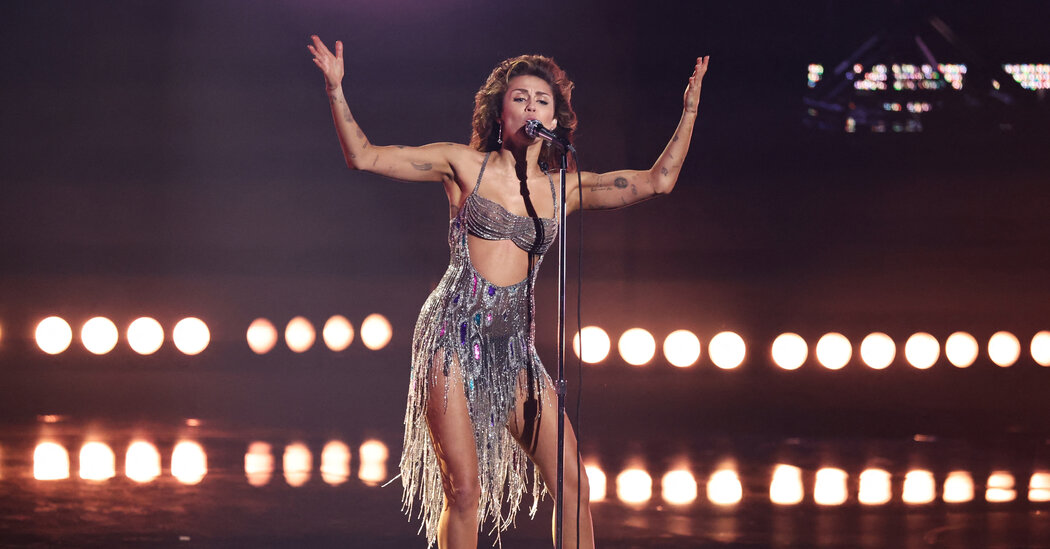The awards show red carpet has become such an access game, such a race of clout and connections to see who can wear the most never-before-seen or sizzlingly-hot-off-the-runway look — the answer, this time, was Beyoncé, in Louis Vuitton men’s wear from Pharrell Williams’s January show — that any other approach can seem like a shock.
But recently a different trend has been emerging, and at the 66th Grammys it reached critical mass. Indeed, it’s so applause worthy, here’s hoping it isn’t a trend at all but rather the signal of a permanent shift in the fashion-Hollywood industrial complex.
I am speaking of the rise of vintage. Or as it is apparently now known, “archival” fashion. “Archival” here is being used to refer to anything that simply isn’t new. (Well, it was getting a little ridiculous to refer to two-season-old clothes as “vintage.”) That could mean clothes from a brand archive, or a personal one. Sometimes also known as a “closet.”
At the Grammys, Laverne Cox, the E! red carpet host, led the way, as she also did at the Emmy Awards, in a Valentine’s Day red contraption from 2015 Comme des Garçons. She chose the look, she said, because that collection had been about “blood and roses” and finding beauty in pain, and, well, it felt particularly apropos.
Then there was Olivia Rodrigo, another vintage disciple (remember the 1995 Chanel suit she wore to the White House?), in a white 1995 Versace siren gown. Also Caroline Polachek in gothic 1998 Olivier Theyskens coursing with crimson veins and arteries. Billie Eilish in an upcycled and customized Chrome Hearts “Barbie” baseball jacket. Lana Del Rey in a found-it-herself puff-sleeve black vintage floral number. Coi Leray in a 2019 Saint Laurent jacket and leotards, no pants.
And that was just the red carpet! Inside the Crypto.com Arena, Oprah wore a vintage sequined Valentino couture 2004-5 shirtdress straight from her closet, as she wrote on Instagram, to introduce her part of the “In Memoriam” segment of the show, and Miley Cyrus wore a vintage silver fringed Bob Mackie to perform her song “Flowers.”
Ms. Cyrus wore three other outfits during the evening: a peekaboo Maison Margiela Cleopatra dress made entirely of gold safety pins for her entrance; a black beaded halter-neck Tom Ford jumpsuit when she won best pop solo performance; and a chocolate sequined Gucci gown when she won record of the year. Which is both a reflection of the current state of style and the perfect example of why vintage is such a smart solution.
The obsessive interest in the red carpet, which despite efforts to Ask Her More is clearly not going away, has turned that particular phenomenon into a marketing tool used by fashion brands to sell more and more stuff; to promulgate the idea that no one should ever appear in the same thing twice. Not even, it seems, at the same awards show!
(There is an unfortunate new trend of celebrities wearing one dress to make their entrance and another to actually sit in their seats. Dua Lipa, for example, wore Courrèges on the red carpet, performed in Mugler by Casey Cadwallader and then switched to a backless black jersey number at the table.)
The result is a virtuous, or vicious, cycle of anticipation and consumption, depending on your point of view. Even if some of the celebrities give the clothes back the next day — and let’s be honest, if it’s a custom job, they just keep it — the signal absorbed by the watching world is of the constant need for newness.
Which, given what we know about the climate crisis and the fact that the simplest route to more sustainable fashion is fashion that is worn longer, is the opposite of the behavior that anyone in the public eye should be modeling.
Vintage changes all that.
It allows celebrities to show off their ability to access clothes that are otherwise unavailable to the public.
It allows brands to maintain their relationships with said celebrities — and takes some of the pressure off designers and their teams to create entirely new individual outfits at the same time that they are creating full collections for the ready-to-wear shows. (Daniel Roseberry of Schiaparelli, who dressed Taylor Swift in a custom look for the Grammys, recently told me that designing for award season was like making a full second collection.) Also, it bolsters their heritage and environmental cred.
And it shows the watching world that perhaps the best new dress for a special occasion is actually an old dress. Or at least one that already exists. As far as I am concerned, that deserves an award all its own. Here’s hoping the Oscar stylists take note.







